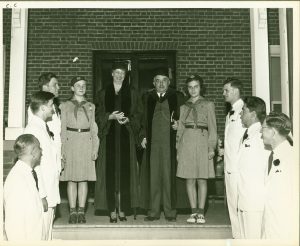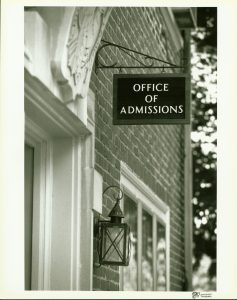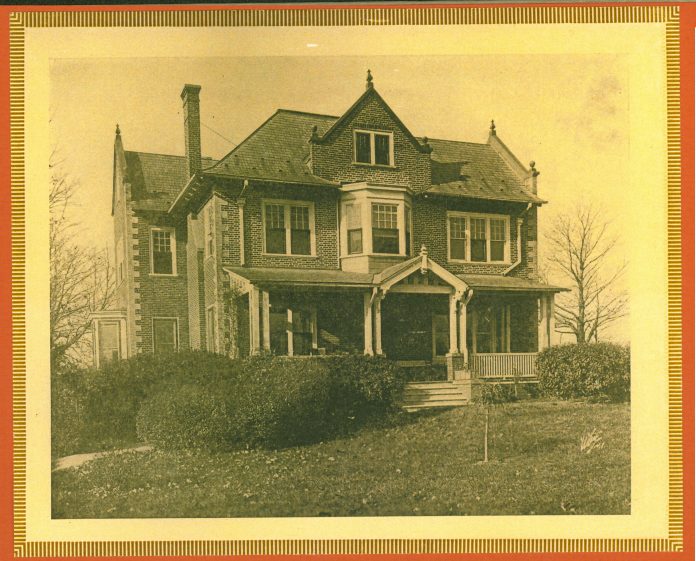“This Week in Muhlenberg College History” will bring to light past events, individuals, and forgotten aspects of Muhlenberg history that have been buried within the College’s 170 years of existence.
Though many of us have never entered the building nor even know where it is, we have all heard of the Wescoe School. The building, however, has housed far more than the adult learning school in its long history. Constructed in 1905, the John Peter Gabriel House, formerly the President’s House, is one of the oldest buildings on campus and has overlooked the College’s front lawn for more than 110 years. Throughout this time, the College has undergone a plethora of changes, and the Gabriel House is no different. From the residence of the president to its now uncertain future as the Wescoe School, the Gabriel House’s history is as fascinating as the people that have graced its halls.

Already the subject of a previous History article, President Haas was the biggest catalyst of change the College had ever seen. Not only was he the longest serving president, but he oversaw a massive expansion of the College’s new Allentown campus in his more than 30 year tenure. One such expansion was a home for himself, placed nicely in front of the the Administration Building, now Ettinger. In 1904, the only buildings on campus were the Ettinger, Berks Hall (now East), and the Power House (now the Plant Operations Building). The decision was made to keep the College’s esteemed president a little closer to his pupils, so they broke ground in mid-1904 to complete his housing as quickly as possible.
Though no definitive evidence is present, rumor has it that the President’s House was actually supposed to be south of Chew Street, not in its present location. According to the President’s Report of 1946, the original intent was to place the building on the opposite side of Chew, at the present site of Trexler Library, but doesn’t elaborate further than that. Though it is unclear how this simple blunder went unnoticed during its construction, if it was true, it would be yet another piece in the fascinating history of the Gabriel House.
For most of its life, the President’s House remained just that: a home for the president to live in. Though its modern counterpart is located on Leh Street, the intimate nature of such a small campus facilitated its leader to remain close. Though the home could be described as simple, its guests were often far from it: the most notable guest to walk through its doors was Eleanor Roosevelt, the 31st First Lady of the United States. Roosevelt visited campus on May 26, 1942 to commemorate the bicentennial of the Muhlenberg family’s landing in Pennsylvania, and spent the first part of her day with President Levering Tyson and his wife. After some pleasant- ries and a nice meal, she spoke at the celebration on the role of women in politics and received an honorary degree from the College.

Gabriel House. Photo Courtesy of the Muhlenberg College Archives
Though not always home to such esteemed guests, the Gabriel House remained the home of the presidential family until 1964. In June of 1963, the Board of Trustees made order to purchase a house on 2333 Liberty Street, across from the Gymnasium, and “the English-style stone and stucco house” on 339 Leh St. After a few renovations and improvements, Dr. Erling Jensen, the College’s 7th president, was ready to move in at the end of the Spring Semester of ‘64. The vacancy at the President’s House was filled by Thad Marsh, Dean of the College; the name of the building appropriately changed from “President’s House” to “Dean of the College House.”
Finding different uses after the Dean moved out in 1967, the House bore the name “Education and Mathematics Building” and “Admissions House” before its contemporary title of “John Peter Gabriel House” came to be. It would, however, be 20 more years of name changes and additions before the name “Wescoe” was attached to the building. In the meantime, it became an office building for a myriad of different departments and for a short period even held some classrooms.
In 1990, it became the “Center for Adult Education,” but is wasn’t until 1999 that the “Wescoe School of Professional Studies” was officially housed in the Gabriel House. The Wescoe School, undoubtedly to be the subject of a future article, was yet another step ‘towards a greater Muhlenberg.’

Though the main focus of these articles are to dwell on Muhlenberg’s forgotten past, in this case, we must now also look to the near future. With the history behind the Gabriel House being one integral to the growth of this campus, its planned destruction as part of the new proposed Master Plan should come as quite a surprise. Every Muhlenberg administration has strived to pave a path towards ‘a greater Muhlenberg,’ and campus renovations often came along that path. However, very rarely does that path pave over its history as it progresses: the only time that comes to mind that a campus building has been leveled to make way for something new is the demolition of the Bernheim House.
It is the opinion of this history writer that the future of this College should not see the destruction of its past to make room for its future, but instead a humble cohabitation that highlights both this College’s historic past and its groundbreaking developments.
Karl Schultz is a Senior with a History major, German minor, and a certification in secondary education. He began writing for the Weekly his freshman year after his roommate, now Editor-in-Chief, forced him to. He mainly writes about Muhlenberg College's forgotten past through his "This Week in Muhlenberg History" segment.























Thanks for sharing the history on the Gabriel House. Did not like seeing it disappear in the Campus Master Plan!